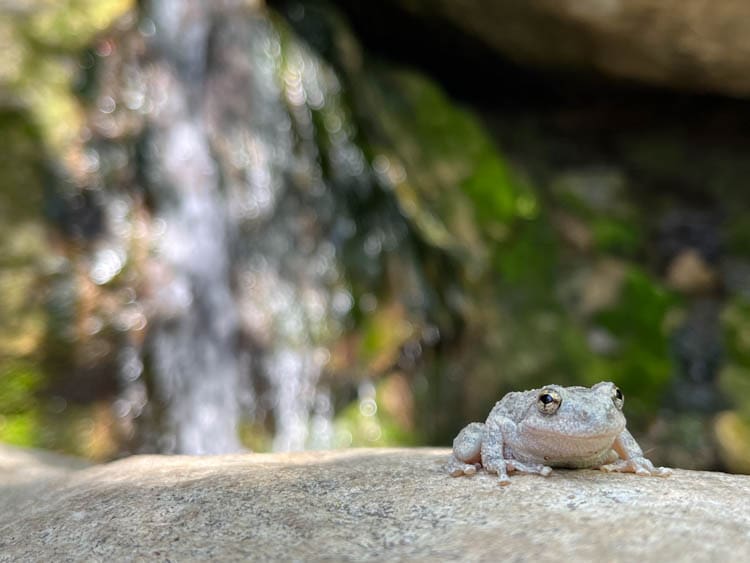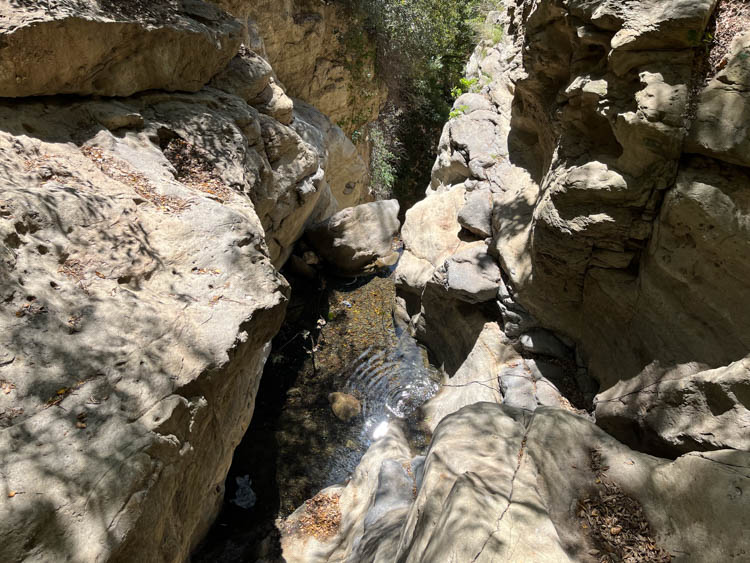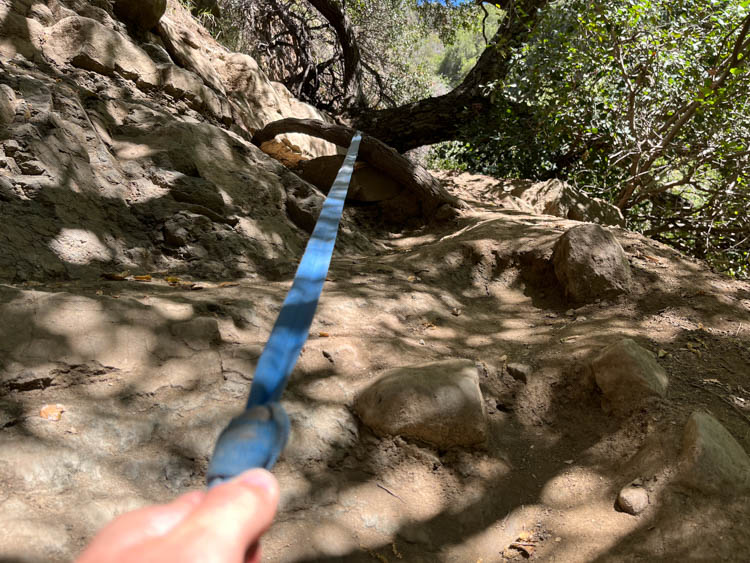
Go World Travel is reader-supported and may earn a commission from purchases made through links in this piece.
I slowly opened my eyes around 6:00 am and noticed the sound of the cooling fan. Why does everything sound so much louder in an otherwise silent room?
It was still 30 minutes away from sunrise and I could only see the lights of other apartments shining through blinds that danced in the gentle wind.
Knowing that I would not be unable to go back to sleep, I decided to go out and explore a hiking path in my new home in Orange County, California.

Choosing the Black Star Canyon Hike
Having already enjoyed some amazing previous hikes, it didn’t take much convincing to get up, prepare and leave early. The only thing missing was selecting a destination. After a bit of scrolling around Google Maps, I decided to give Black Star Canyon a chance.
It is a remote canyon located in the Santa Ana Mountains within the eastern part of Orange County. Mixed reviews and partly promising pictures not only piqued my interest but also created a perfect foundation for an adventure trip into unknown territory.
I had driven halfway to the starting point of the hike when I realized I had forgotten to take water. I guess I was a bit too excited to leave.
Unfortunately, at this point, there was neither a gas station or a store for the last 15 minutes of my drive. Luckily, two minutes before reaching the trailhead parking lot, I spotted a sign that advertised a small market in a town called Silverado.

Saved by Silverado
Driven by the fear of dehydration, I followed the advertisement for two miles and was rewarded by a beautiful little town that looked a bit out of place.
It reminded me of an old western movie. It turns out this town is the starting point of many hiking trails and serves as an amazing spot to stock up on supplies before starting a day trip.
I bought some power bars and water and chatted with the shop assistant before heading back to my original destination, the parking lot of Black Star Canyon.
Finding this place and getting there was extremely easy. It only took me about 35 minutes from my apartment and the directions were clear. There was an information sign offering a few brief words about park rules, dog restrictions and alcohol abuse.
In addition, there was a pretty intimidating list of inherent dangers, including mountain lions, rattlesnakes, poison oak, poisonous insects, weather extremes, loose rocks and rugged terrain. Most of these points can be found on almost every park sign around the area, so I did not think much of it and started my hike.

Starting the Hike
The first third of the 7-mile (11.4 km) hike was easy. As this was a loop hike it meant that the final third of my return would also be easy.
I walked on a relatively wide dirt road while feeling a slight incline as I moved along. The first potential problem was given by the almost consistent exposure to sunlight. During this part of the hike, there were barely any trees and therefore little shade.
Furthermore, there was nothing to see at all. The surroundings were quite unspectacular and boring. The only time I actually stopped was when a cute peacock came walking toward me.
It had no way to go other than the path I was on, so I stepped aside, sat down, and patiently watched the animal as it carefully decided to walk past me.

Finding the Black Canyon Falls Trail
Shortly after my peacock experience (about 40 minutes into the hike), I reached the major waypoint that directed me towards the “Black Canyon Falls Trail”. After turning right towards the river/stream, the real “fun” began. At first, I didn’t think much of it.
The ground was still pretty flat and it was quite easy to spot where I had to go. However, as I got further into the canyon, I suddenly felt a rapid increase in temperature.
The cloudy sky opened to unleash the full power of the sun into the valley. Also, there was an abrupt absence of wind that made me feel like I was walking inside an oven.
Even though it had been raining just a few days before I got there, I noticed a rather low water level in the stream. Luckily, this made it very easy to cross the water when needed. This was inevitable since the trail sometimes ended on one side of the river and continued on the other.
On top of the uncomfortable feeling caused by the increasing heat, I now started to realize that the incline continuously became steeper as I moved forward. Furthermore, the path became more unclear to spot and small stones and rocks slowly turned into large boulders, barring the path.
With every bit of the path that I put behind me, the boulders became bigger and, before I really noticed what was going on, there was no obvious path anymore.

Challenging Boulders and Inclines
While initially fun, this endeavor turned out to be increasingly challenging. The climbs got harder, the boulders partly slippery and the overall experience a bit too frustrating.
Some of the inclines were so steep that ropes were tied to the surrounding trees, making it easier for people to pull themselves up. In other parts, the only possible path to walk was almost entirely overgrown with plants, including poison oak.
Luckily, in consideration of this potential danger, I was wearing a long sleeve shirt and hiking pants covering my entire legs.
After about 1 hour and 15 minutes, I needed a break. At this point, I regretted carrying 6 kg worth of camera gear in my backpack, which, so far, had only served the purpose of tiring my legs out. As I was sitting down, I thought about how much of my water I should drink to still have some reserves for later.

Cute Californian Treefrog
While carefully sipping on my water bottle, I was staring at a tiny stream right next to me, which turned into a miniature waterfall between two boulders. I slowly followed the flow of the water downwards and suddenly spotted a cute Californian Treefrog (Pseudacris Cadaverina), peacefully relaxing in front of the water.
As a wildlife photographer, this was a perfect picture opportunity. I lost time for a little while taking almost 70 pictures of the frog from different angles. Finally, I felt rested enough to move on, still not knowing how much further I had to go (I had lost my GPS signal a while ago).
After my time-consuming photo shooting with the frog, it only took me another 15 minutes of intense climbing until I reached the waterfall. Or, to be more precise, the spot where the waterfall should have been.

Disappointing Waterfall
There was a bit of water but nothing that I would consider an actual waterfall. I took a few pictures and looked around to see if there was anything else I could do or see.
Besides the actual “waterfall”, there was a small cave to its left, which I could have entered by climbing up the rock right in front of it. I decided not to try because the rock was entirely covered with water and algae, making it extremely slippery.
Being quite exhausted usually comes with a lack of concentration and reduced motor skills, a lesson I have learned through several injuries in the past.
As I turned around with the intention to start making my way back, I saw more ropes to my left (at the right side of the waterfall when facing it).
Since I hadn’t really seen anything spectacular until this point (aside from the friendly frog), I decided to make my way up and climbed as far as the ropes allowed.
This part was so steep that it could not be done without holding on to the ropes. Once I reached a sort of plateau, I followed what looked like a footpath.

Climbing to a View
Just a short 3-minute walk later, alongside the steep edge of the mountain, I found myself above the waterfall and spotted a tiny natural pool. If the water level had been a bit higher, I would have surely taken a bath there.
After all, I did not see any other person since I entered the canyon. However, it wasn’t inviting enough, so I turned around.
I carefully walked back towards the ropes while at least enjoying a beautiful view of the valley. The way back down was easier than expected but had to be treated with absolute caution. If I had slipped and/or lost grip of one of the ropes, potential injuries could have been severe, if not fatal.
Usually, walking up one way makes it very easy to walk back the same way downwards. Not in this case. At least not as long as I was inside the canyon.
While having to still constantly climb boulders, I couldn’t feel the decline of the path at all. In addition, the tiredness of my legs made it hard to move forward without frequent breaks. Eventually, I made it out of the canyon.
When compared to the canyon trail, the dirt road now felt like a blessing and was so much easier to walk. The only downside: I spent about 3 hours inside the canyon, so the sun was now in its prime spot.
As mentioned before, there was barely any shade during this part of the trail. This made it feel like the final stretch of my journey would never end.
The absence of anything interesting along the way made it almost unbearable to move forward. I stared at the ground and watched my feet slowly dragging through the sandy ground.
Once I was back in the car, I spent 15 minutes drinking water and relaxing, while waiting for the air conditioner to kick in and cool me down. What an endeavor.

Personal Thoughts on the Black Star Canyon Hike
In summary, I would say that this trail is on the harder side of moderate. Sure, if you are in really good shape and like to climb rocks, this may be your thing. However, this is no hike for people that just want to see some nature while casually walking.
The absence of the waterfall itself was the major disappointment of my hike. However, I would not recommend attempting to do this trail to see the waterfall when water levels are higher.
Although higher water levels may guarantee a proper waterfall, this also means that the river crossing is harder and rocks/boulders are more slippery. In my opinion, the effort is not worth the reward.
Besides the poison oak, treacherous climbing through the boulders and potential heat exhaustion, there is simply nothing to see until the waterfall itself, which is not even that impressive.
This is not a hike; this is simply exercise. If burning calories is your goal, this is your trail. Should you be looking for a scenic hike with much variety, avoid this area and visit nearby trails instead (Aliso & Wood Canyons Wilderness Park or Whiting Ranch Wilderness Park).

Tips for Hiking to Black Star Canyon Falls
Now you are aware of the potential dangers and you know exactly what to expect. Are you still interested in going? Here are a few things to consider:
- Stock up on food and drinks in Silverton. There is a very cute and authentic market with friendly staff that is happy to answer all your question about the area. In fact, Black Star Canyon has been the site of many negative events in history and is, according to some people, the most haunted location in Orange County. Check out the OC Ghosts & Legends website for more information on that.
- Always wear long-sleeve shirts and pants covering your legs to prevent exposure to poisonous plants
- Wear solid hiking boots with a good grip to avoid slipping while scrambling over the boulders. Waterproof shoes are highly recommended since it is necessary to cross the stream occasionally.
- Keep your eyes on the ground and be aware of rattlesnakes.
- Leave as early as possible to avoid sun exposure and heat exhaustion, especially during the first/last third of the trail
- Know your limits. When getting tired, do not try to climb to the higher parts of the waterfall using the ropes. The risk of injury is way too high.
- For general information about hiking trails and fees, visit the OC Parks website.
Author Bio: Thomas Später is an experienced backpacking traveler that specializes in adventurous trips around the globe. He has traveled to remote and exotic places, such as Namibia or Mongolia and focuses on landscape and wildlife photography to share the beauty of our planet with others. In 2021, Thomas published a (german) book about Overpopulation and overconsumption (Die Überbevölkerung). With his awareness of current global issues, he uses his travels to support particularly local hotels and restaurants to raise awareness for the nature and culture of his destinations.

